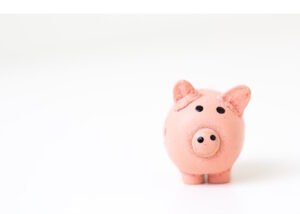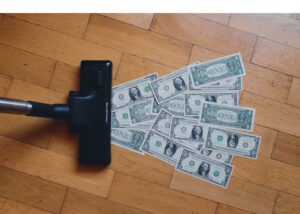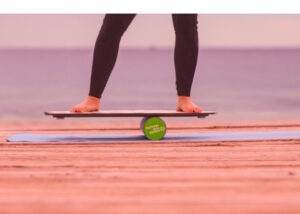You’ve spent your life working, saving, investing. Then you retire. No paycheck coming in, but money going out. You have to create your own paycheck now.
If you’re unsure on how to structure your portfolio to generate enough income at retirement, here is the approach I use with my portfolio as part of my retirement strategy.
It all starts with a budget
 Before creating yourself a paycheck, you must know how much you need. It’s a crucial step; if not completed thoroughly, you could live with a great deal of uncertainty.
Before creating yourself a paycheck, you must know how much you need. It’s a crucial step; if not completed thoroughly, you could live with a great deal of uncertainty.
List your monthly expenses, then add your yearly expenses, you know, the “one-time” expenses we incur inevitably each year but that we keep forgetting, car repair, household maintenance, etc.
Next, look at your sources of income. Will you have a company or government pension in retirement? You need these numbers to know exactly how big of a paycheck you need from your portfolio to cover your budget and not outlive your portfolio’s assets.
Cash reserve
Suppose that, after deducting the other retirement income from your total expenses, you need $30,000 from your portfolio per year. Ideally, you’d have at least that amount, or double, in cash when you retire. That cash reserve gives you up to two years’ worth of your budget readily accessible without having to liquidate any long-term investments. The goal of retirement is to enjoy life; sleeping well helps.
With a cash reserve, you can make the best investment decisions no matter what happens in the market. Another pandemic makes your portfolio melt by 30% overnight? You don’t have to do anything; keep withdrawing cash from your own “ATM” each month. The crash won’t affect your retirement for at least 2 years, usually long enough for the market to recover.
 To create a cash reserve, you can stop reinvesting your dividends a few years before retiring and let the cash build up. It’s simple, but during that time the cash doesn’t generate meaningful returns.
To create a cash reserve, you can stop reinvesting your dividends a few years before retiring and let the cash build up. It’s simple, but during that time the cash doesn’t generate meaningful returns.
You could let your portfolio work until the last moment and sell one- or two-years’ worth of your budget in shares on day 1 of retirement. However, it might happen at the bottom of the market, a very bad time to sell.
Either way, you need that cushion to retire. Learn more about this in Retirement Cash Reserve: Surf the Market’s Waves. Next: make sure you can always generate a big enough paycheck.
Build Your Safe Money Printing Machine
You’re now ready to make your portfolio a safe money printing machine, “safe” being the operative word.
When retired, you have many years ahead of you. Statista shows that once you reach 65, your odds of blowing out 80 candles or more are very good. You’ll live through multiple bull and bear markets. Let’s make sure you don’t outlive your portfolio, shall we? Dividend investors generate income in two ways, from dividends and from capital gains.
Dividends
If you can get your income entirely from the dividends received from your investments, great! Need $30,000? If you have $800,000 invested, divide $30K by $800K; ensure your portfolio averages 3.75% in dividend yield, and you’re done!
If all you need is a 3 to 4% yield, you won’t have much to worry about. In fact, you might be able to cut down your cash cushion to 1-year of retirement budget and be just fine.
Build your money printing machine with stock ideas from our Rock Stars List – Download it here.
What if you need more than 3-4% yield?
Unfortunately, many retirees are in more difficult situations, like needing $50,000 per year while having $600,000 invested. This requires an 8.3% yield. Generating that yield consistently is not easy.
There are investments that offer generous 8%+ yields, such as high-income products and high-yield stocks. Are they the solution for retirees needing more than their current dividend payments?
High-income products such as Master Limited Partnerships (MLPs) or split share corporations seem attractive. However, their long-term returns often reveal flat payouts, which means that it gets eaten up by inflation, and even declining asset value (stock price).
 As for a stock with a very high yield, I see that as a red flag. Often, the companies use a lot of their money to pay dividends instead of investing in growth, and it catches up with them, and their investors later on. In fact, some 8% yielders eventually cut their dividend and suffer massive capital loss.
As for a stock with a very high yield, I see that as a red flag. Often, the companies use a lot of their money to pay dividends instead of investing in growth, and it catches up with them, and their investors later on. In fact, some 8% yielders eventually cut their dividend and suffer massive capital loss.
Click here to see an article that shows 10-year returns of some high-income and high-yield investments.
High-income products and high-yield stocks are not what I call safe money-printing machines. My preferred solution for generating a paycheck in retirement? Make your own dividend.
Make-your-own-dividend
I’m a dividend growth investor. I use dividend metrics to select stocks. My goal is to generate the best possible return, so I focus on total return; this includes both dividends and capital gains.
Even with a modest average dividend yield, I can make my own dividend by selling some shares of high growth stocks that have appreciated handsomely. I avoid the downsides of high-yield products, and often get higher total returns than high-yield stocks.
Find great stocks on our Rock Stars List – Download it here.
Take Alimentation Couche-Tard (ATD.TO); growth-oriented, impressive dividend growth (22% CAGR over 5 years), but a mediocre yield (0.80%). Couche-Tard offers a low yield because it focuses heavily on growth, using most of its money to grow the business and add value for shareholders.
What about total return? For the last 10 years, it exceeds 600%! An investment of $100K back then, with reinvested dividends, is now worth over $700K!
Of course, in retirement, you want higher yield sure shots in your portfolio—utilities, REITs—for stability and a decent expectation of good income year after year.
 Striking a balance between low yield, high growth stocks and classic “retirement stocks” can create the perfect blended retirement portfolio. Rather than a high yield, Couche-Tard give you high growth. When retired, simply sell a few shares as needed to generate your own dividend.
Striking a balance between low yield, high growth stocks and classic “retirement stocks” can create the perfect blended retirement portfolio. Rather than a high yield, Couche-Tard give you high growth. When retired, simply sell a few shares as needed to generate your own dividend.
Value is value, whether it’s the dividend or the share value. Build a portfolio filled with amazing dividend growers, and you won’t have to worry about your average dividend yield.


Leave a Reply